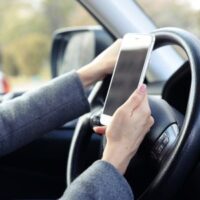California’s ‘No Touch’ Law: A Closer Look

The Golden State did not pass a hands-free cell phone law until 2017, substantially later than other states acted. This law prohibits drivers from holding and using cell phones or other devices, except in limited circumstances. But California’s updated “no touch” law, which went into effect in July 2025, makes it clear that “touching” a cell phone for any purpose, even to use GPS navigation, is against the law, unless the device is in hands-free configuration.
The updated no-touch law, which closes a significant loophole in the hands-free law, makes it easier for a San Marcos personal injury lawyer to obtain compensation in device distraction car accident cases. This compensation usually includes money for economic losses, such as medical bills, and noneconomic losses, such as pain and suffering. Additional punitive damages are available as well, in some extreme cases.
Device Distraction and Negligence Per Se
If a tortfeasor violates a safety law, such as the hands-free law, and that violation causes a crash, the tortfeasor is liable for the aforementioned damages as a matter of law.
Evidence is still necessary in these cases. Usually, there’s a direct relationship between the amount of evidence a San Marcos personal injury lawyer presents and the amount of compensation a jury awards.
Evidence in a negligence per se or ordinary negligence case usually includes the police accident report (especially if the report states that distraction caused the crash), the tortfeasor’s statements about device use, and the victim’s medical bills.
Negligence per se is only available if an emergency responder cites a tortfeasor. Many emergency responders don’t cite tortfeasors in accident cases as a matter of personal or departmental policy. Many police officers believe that car crashes, even those that cause fatal injuries, are civil matters.
Device Distraction and Ordinary Negligence
The no-touch law is a step in the right direction, but only a step. Device distraction in any form, hand-held or hands-free, kills people. A two-second distraction increases the risk of an accident by over 2,000 percent.
So, there’s a difference between a quick glance at a phone, such as looking at a GPS map, and extended use, such as reading a text or reconfiguring a GPS map. The first instance could result in a wrong-place-at-the-wrong-time accident. The second instance is clearly negligence, or a lack of care.
The line between accident and negligence goes back to evidence. We mentioned some of the evidence in a distracted driving case above. This evidence relates to liability as well as damages. For example, if the tortfeasor caused a severe collision, the tortfeasor was probably badly distracted.
Other evidence in an ordinary negligence distracted driving case includes electronic evidence, such as the gadget’s device use log. This log shows how much, or how little, the tortfeasor was using the device in the moments before the crash.
An attorney must act quickly to preserve electronic evidence, such as the device use log, before the tortfeasor “accidentally” deletes it.
Devices aren’t the only distracting elements inside a vehicle. In fact, they aren’t even the most common elements. Others include eating while driving, arguing with passengers while driving, and drinking while driving.
Work With a Thorough San Diego County Lawyer
Injury victims are entitled to substantial compensation. For a confidential consultation with an experienced personal injury lawyer in San Marcos, contact the Pursley Law Firm. We routinely handle matters throughout the Golden State.

